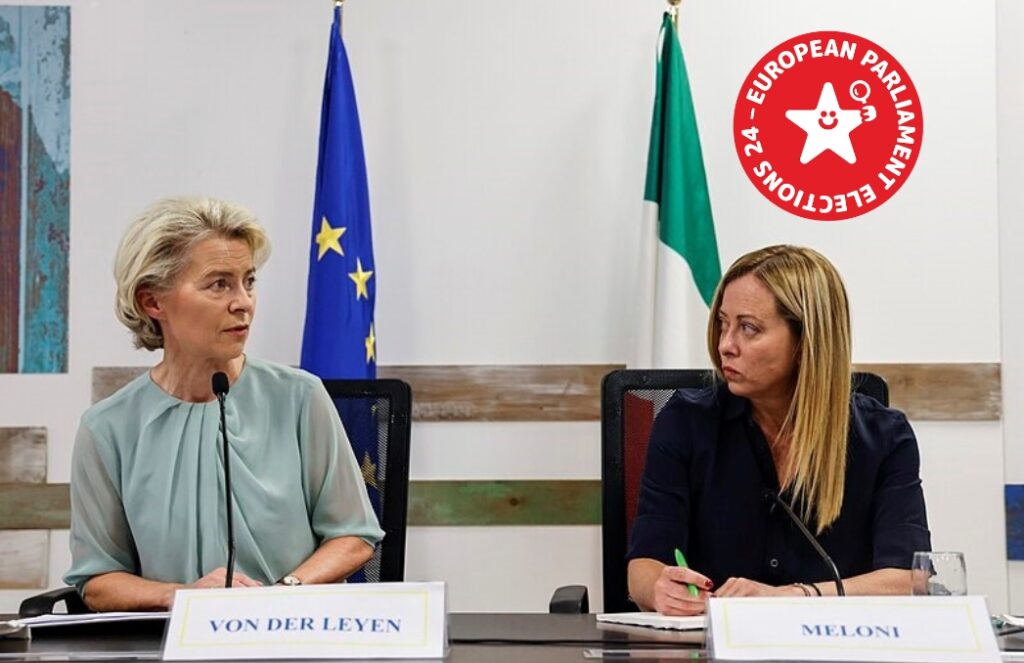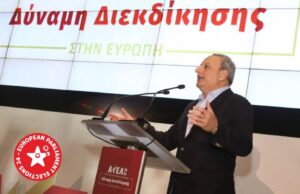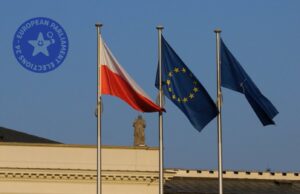
The Italian right, led by a party rooted in neo-fascism, reportedly maintains the support that propelled it to victory in the 2022 elections, according to polls. Meanwhile, the opposition remains fragmented, lacking a cohesive agenda. In European elections, the radical left is divided, presenting conflicting lists.
The political system after the September 2022 elections
The elections of September 2022 increased the electoral success of the right-wing coalition and the dominance of the “Brothers of Italy” (FdI) within it. This party, founded in 2012, considers itself the heir of the Italian Social Movement, an expression of the neo-fascist tendencies that remained on the margins of the Italian political system until the end of the 1980s.
The center-right coalition, comprising not only FdI but also Matteo Salvini’s League and “Forza Italia” (the party founded by the late Silvio Berlusconi), secured 43.79% of the vote, sufficient to clinch an outright majority of seats in Parliament. The vote resulted in a radical restructuring of the balance of power within the right-wing, given that Forza Italia, once the dominant party, obtained 8.11% and the “League”, which has long since abandoned its characterisation as a separatist formation of the northern regions, garnered 8.77%.
The social bloc that supports the centre-right is made up of important business sectors, autonomous and professional middle classes, working classes integrated in leading economic sectors in the north of the country as well as a traditional current of conservative voting behaviour in the south. The issues they focused on were typical of right-wing populism: against taxes and migrants. In the case of (FdI), they were able to mix ethnonationalism, liberalism, xenophobia and conservatism on socio-cultural issues. Meloni’s party also capitalised on its decision to remain in opposition to the “national unity” government led by Mario Draghi.
The government led by Giorgia Meloni has moved with a certain caution and has established good relations with the President of the European Commission Ursula von der Leyen and with the US Administration. Complete alignment in military and economic support for Ukraine and Israel is decisive for such relations.
The government has embarked on a dual restructuring of the institutional framework outlined in the Republican Constitution. Under a mechanism termed “differentiated autonomy,” regional authorities will have the option to petition for additional powers in presently excluded domains. This initiative finds support primarily among northern regions, notably those under League governance (and also in Emilia-Romagna, where the President is from the Partito Democratico – PD). Nevertheless, numerous southern regions and legal experts have expressed reservations, fearing it could bolster the influence of economically affluent territories at the expense of others.
At the same time, the proposal for the direct election of the Prime Minister was presented, which would weaken both the weight of Parliament and the role of the President of the Republic – a change resulting from an authoritarian and hierarchical vision of the state that has always characterised the spirit of neo-fascist tradition. Concerning the migration issue, the government has initiated various agreements with North African states (Tunisia, Egypt) to block departures which, however, have not diminished.
On key campaign issues like the flat tax proposal and halting migrant arrivals, the right’s electoral agenda has not yielded tangible results for the government. Additionally, despite an initial economic rebound from the Covid-19 crisis, Italy’s economic condition appears to be slipping back into the stagnation that has persisted for decades. However, these challenges haven’t yet impacted the government’s level of public support.
The victory of the right was also the effect of the fragmentation of the forces that relate to the centre left. In 2022 they were divided into three camps. The PD could count on the agreement with the Alliance between the Greens and the Italian Left (AVS) and “Più Europa” (a liberal formation led by Emma Bonino), obtaining a total of 26.12%. AVS, led by Nicola Fratoianni (Sinistra Italiana, which originated in a split from Rifondazione Comunista in 2009) and Angelo Bonelli (Greens) obtained 3.64%, managing to win 12 seats in the Chamber of Deputies and 4 in the Senate. The 5 Star Movement, without allied parties, collected 15.43%. A centrist formation of defectors from the Democratic Party, led by former leader Matteo Renzi and former MEP Carlo Calenda, collected 7.78%. A coalition that held all these forces together could have counted on an overall percentage significantly higher than that of the centre-right, but the profound existing differences made a convergence of all these parties impracticable. A PD-M5S coalition, rejected by the leader of the PD back then, Enrico Letta, would certainly have been more competitive against the right.
The PD presented itself in the elections as the continuation of Mario Draghi’s policies. The negative result brought a new crisis to the party which led to the election of Elly Schlein, who returned to the PD precisely to compete for the role of leader. The mechanism of the double primaries, a first round within the party and a second open to all voters, favoured a candidacy oriented more to the left compared to the policies followed by the PD in recent years. However, Schlein’s leadership has so far oscillated in a contradictory way between personal preferences and the need to consider the orientations within the party which have tended to slow down its push for change.
The 5 Star Movement today is decisively on the progressive side but with contradictions. That is, sometimes it appears to be to the left of the PD, with a less Atlanticist foreign-policy vision for example, at other times to its right, on the issue of migration for example. The electoral consensus of the Movement, led by former Prime Minister Giuseppe Conte, was favoured by the defence of the “citizen’s income” (a measure intended to fight poverty), cancelled by the Meloni government.
In 2022, a list of the radical left was also presented, outside of any alliance, called Unione Popolare, which included the Party of the Communist Refoundation (PRC), Potere al Popolo (PaP, founded in 2017) and other smaller groups, led by the former mayor of Naples Luigi De Magistris. Having collected 1.43% it was unable to enter Parliament. Unlike Sinistra Italiana – which chose the alliance with the PD – the PRC and PaP aimed to form a new political-electoral pole alternative not only to the right, but also to the PD and the M5S.
Alignment in European political families
The centre-right political forces belong to three different groups in the European Parliament. FdI has joined the European Conservatives and Reformists group and Giorgia Meloni is president of the corresponding European party (ECR). With the loss of the government by the Polish PiS, Fratelli d’Italia is now the most influential group in the ECR.
Salvini’s League aligns with the radical right group, Identity and Democracy, although some within the party have expressed impatience in recent weeks. Many members view the I&D group as overly extremist and advocate for seeking more pragmatic European allies instead.
Forza Italia is integrated into the European People’s Party and, with the passing of Berlusconi (who always maintained his friendship with Putin), some of the cause for embarrassment among its European partners has disappeared.
The Democratic Party is included in the Social Democratic group. In the recent Party of European Socialists congress held in Rome, the positions espoused by Elly Schlein were not particularly left-wing.
The AVS coalition, now represented in the European Parliament by a former member of the PD, has seen the green component joining the corresponding European party. Meanwhile, Sinistra Italiana continues to engage with various groups within the radical left (Party of the European Left, “Now the people”). AVS future MEPs may join either the Greens or The Left group.
The Communist Refoundation Party has always been part of the The Left group since it had a presence in the European Parliament and is active in the Party of the European Left of which it is one of the founding members.
The European elections
The mainstream parties will participate in the next European elections with their own names and symbols. In the case of the PD, the electoral lists include some figures from civil society in order to attract especially those voters who do not share the position taken by the party on the war in Ukraine.
To the left of the PD, the presentation of two competing lists is currently expected. The Alleanza Verdi Sinistra Italiana intends to confirm its autonomous candidacy. Its lists will include some independents such as the former mayor of Riace, Mimmo Lucano, the MEP, elected on the PD lists Massimiliano Smeriglio and the former mayors of Rome and Palermo from the PD. These figures lead the list to appeal above all to traditional voters of the Democratic Party.
A list that does not want to be explicitly characterised as “left-wing” as it seeks to gather votes from a broader electorate, is the one promoted by Michele Santoro, a popular left-wing television journalist, and by Raniero La Valle, a historical figure (he is 93 years old) of progressive Catholicism and pacifism. The list, called “Peace, Land, Dignity” (PTD), is open to intellectuals, political personalities and exponents of civil society of various orientations who, however, believe that an active commitment against militarism and the danger of a world conflict is central. For Ukraine, they believe that it is necessary to seek a solution that involves a ceasefire and the start of negotiations. In this case AVS also expresses similar positions.
The “Peace, Land, Dignity” (PTD) list is actively supported by the PRC. Mera25, the Italian branch of the movement led by Yanis Varoufakis, has also joined it.
Due to a change in the electoral law, the PTD list must collect 75,000 signatures for presentation, of which at least 1,500 in each region. A significant mobilisation is underway throughout the country to help achieving this goal.
The possibility of convergence of AVS and PTD in a single list, which theoretically would make it possible to pass the 4% threshold, remains open but unlikely now. Former PRC leader, now independent, Fausto Bertinotti has endorsed the idea of merging into a single list, a possibility that remains viable until the list presentation date, as it wouldn’t necessitate signature collection. In 2019 the La Sinistra list, which united Sinistra Italiana and the PRC, was presented and obtained 1.75% while the Greens collected 2.32%.
The picture provided by the most recent poll (Demopolis) does not foresee sensational changes for the major parties, but the exclusion of both leftist lists: FdI 27.0%, PD 20.0%, M5S 15.8%, FI 8.7%, Lega 8.0%, Italia Viva and Più Europa 4.6%, AVS 3.8%, Action (centrist) 3.5%, PTD 2.2%.
Italian public opinion is critical of military support for Ukraine
Italian public opinion, according to the Demopolis poll, “continues to be quite critical of the role and policies of the EU, but not of an ‘Italian Brexit’”. On the right, it is above all Salvini’s League that expresses Eurosceptic sentiments, while the “Brothers of Italy” have eliminated the more explicitly polemical arguments, aiming instead to influence European policies on migration, climate change and economic policies. Regarding the war in Ukraine, 52% of Italians think that the priority is to stop the war and focus on negotiations between the parties.
The political landscape is currently influenced by some regional elections scheduled in recent months and by the reelection of local administrations which will coincide with the European elections. The centre-left is still encountering many difficulties in reaching common agreements and presenting common candidates. The 5 Star Movement is trying to present itself as a force for renewal also with respect to the governance practices of the local administrations of the PD, which are not always transparent and free from the influence of power groups and lobbies.
Conclusion
Now, according to polls, the right and in particular Giorgia Meloni’s party, despite some hiccups along the way, is maintaining a high level of consensus, while the League will be reduced in size and may be shaken by internal conflicts and Forza Italia seems to have absorbed the passing of its founder Berlusconi without difficulty. On the centre-left, it is above all Elly Schlein who needs a positive result to consolidate her still precarious leadership.
The radical left remains divided between those who are in favour of a centre-left alliance, maintaining privileged relations with the PD, and another part which instead aims at full autonomy. This division, which is currently difficult to overcome, represents an obstacle to the reconstruction of a significant force to the left of the PD and the M5S.
Cover Photo: On the left Ursula von der Leyen, President of the European Commission, on the right Giorgia Meloni, Italian Prime Minister. Source: Wikimedia Commons



